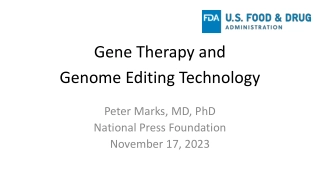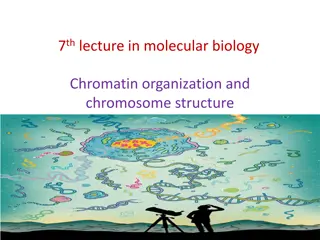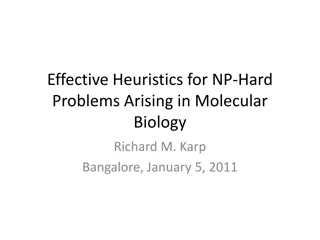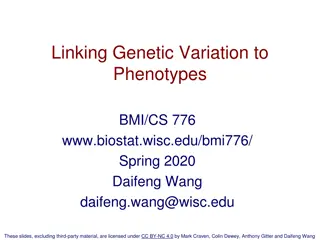Gene Therapy and Genome Editing Technology
This article provides insights into the status, regulatory considerations, and delivery methods of gene therapy and genome editing technologies. It discusses approved gene therapies in the US, human genome editing in clinical applications, and the regulatory authority of the FDA over gene therapy. T
2 views • 27 slides
Insights into Genome Assembly and Shotgun Sequencing
Explore the world of genome assembly, shotgun sequencing, and the fundamental concepts behind deriving genomes from large sets of sequencing reads. Learn about the complexity and core algorithms involved in contemporary genome assembly processes. Discover how the shotgun concept has revolutionized g
2 views • 66 slides
Sudden Death and Cardiomyopathy Associated with LMNA in Nova Scotia Duck Tolling Retriever
A study on sudden death and cardiomyopathy in Nova Scotia Duck Tolling Retrievers due to LMNA association. The research includes genetic mapping, genotype verification, and functional predictions on Lamin A/C effects. Echocardiogram findings, pedigree data, genome-wide association study, whole-genom
0 views • 13 slides
Understanding Genome-Wide Association Studies in Statistical Genetics Workshop
Explore the essentials of Genome-Wide Association Studies (GWAS) and genetic data quality control as presented by Daniel Howrigan in the 2023 workshop. Delve into the goals of GWAS, genetic data characteristics, SNP variations, and genotyping techniques. Gain insights into moving from trait heritabi
0 views • 35 slides
Understanding Transcription and Translation of Virus Genome
The lecture covers the transcription and translation processes of virus genomes, including the Baltimore classification system, transcription control in eukaryotes, and the role of transcription factors in gene expression. It explores how different viruses replicate based on their genome type and me
0 views • 14 slides
Genome Assembly
Genome assembly is a technique to assemble short DNA fragments into a organized format.
0 views • 15 slides
Patient Choice for Whole Genome Sequencing in NHS: Education & Training Slide Deck
Developed by Genomics Education Programme, these slides focus on the patient choice consent model for whole genome sequencing in NHS Genomic Medicine Service. The model aims to ensure informed choices for genomic testing, including participation in the National Genomic Research Library. It covers se
0 views • 34 slides
Genetic Manipulation in Environmental Biotechnology
Genetic manipulation strategies in environmental biotechnology involve techniques like gene splicing and molecular cloning to modify genes directly. These methods have various applications such as isolating genes, producing specific molecules, improving biochemical production, creating organisms wit
0 views • 20 slides
Understanding a Complex KMT2A Rearrangement in AML with Optical Genome Mapping
A case report explores the use of optical genome mapping (OGM) to unravel a complex KMT2A rearrangement in an AML patient. Traditional cytogenetic analyses identified translocations and rearrangements involving chromosomes 10 and 11, leading to the fusion of genes KMT2A and MLLT10. OGM technique, ut
3 views • 5 slides
Understanding the Cancer Genome Atlas (TCGA) Project
The Cancer Genome Atlas (TCGA) project, initiated in 2005, aims to identify genetic mutations in cancer through genome sequencing. Supervised by the Center for Cancer Genomics, TCGA has expanded over the years, publishing numerous research articles and involving various tumor types. The project has
0 views • 7 slides
Understanding Ethical Considerations in Manipulated Photography for Media
Ethical control in photojournalism involves capturing non-fiction events without manipulation, but some control over the image is acceptable within ethical bounds. However, moving into manipulated images for non-news events requires a different approach, involving subject and scene manipulation for
0 views • 28 slides
Evaluating Genomic Science: Insight into Genome Canada's Mission and Impact
This conversation with Dr. Samantha Evans, Director of Evaluation at Genome Canada, delves into the importance of program evaluation in genomic science. Genome Canada aims to connect ideas, invest in science and technology, and maximize impacts across sectors. The evaluation process involves collect
0 views • 36 slides
How Advanced Algorithms Are Reshaping Data Manipulation
Explore the transformative impact of advanced algorithms on data manipulation in our latest feature. This insightful exploration delves into the sophisticated technologies revolutionizing business analytics and understanding what is data manipulation
0 views • 7 slides
Advancements in Genome Alignment and Sequencing Techniques
Genome alignment plays a crucial role in understanding biological processes and evolutionary history. With the rise of whole genome sequencing, methods such as constrained alignment and longest increasing subsequence have been employed for accurate variant detection. Tools like BLAST, hash tables, a
0 views • 11 slides
Basin Manipulation Simulation Analysis Tool Overview
Basin Manipulation Simulation Analysis Tool provides a comprehensive solution for managing and analyzing basin data, including tasks like basin manipulation, simulation analysis, case management, and defining simulation time steps. The tool allows for easy data entry, visualization of simulation res
2 views • 17 slides
Understanding DNA: A Journey from Friedrich Miescher to Genes and Function
DNA, the hereditary basis of life, was first discovered by Friedrich Miescher in 1869. It consists of chromosomes, plasmids, and organellar DNA, collectively known as the genome. Genes, sequences of DNA, encode proteins and RNA, essential for an organism's functions. The genome is divided into chrom
0 views • 17 slides
Exploring the Evolution of Molecular Biology: From DNA Discovery to Genome Complexity
Uncover the fascinating journey of molecular biology, tracing key milestones from the discovery of DNA to the intricate structure of genes and genomes. Dive into historical breakthroughs, such as understanding the role of genes in producing proteins, the double helix structure of DNA, and the comple
2 views • 30 slides
Understanding Chromatin Organization and Chromosome Structure in Molecular Biology
Chromosomes are the carriers of genetic information in cells, containing genes made of DNA. Chromatin, composed of DNA wrapped around histone proteins, plays a crucial role in organizing genetic material. Humans have 23 pairs of chromosomes, and the Human Genome Project aims to map the human genome.
0 views • 21 slides
Introduction to Genome Informatics: Course Logistics and Algorithm Concepts
This content provides information about a Genome Informatics course, including course logistics, homework policies, and contact details. It also introduces fundamental concepts such as algorithms, their key features, and examples like finding the smallest number among inputs. The course emphasizes l
0 views • 30 slides
Analysis of Lady Macbeth's Manipulation in Shakespeare's Macbeth
In a pivotal moment in Macbeth, Lady Macbeth's manipulation of her husband is showcased when she calls upon supernatural forces to overcome his kindness and convince him to kill Duncan. This extract is crucial in introducing Lady Macbeth's character and power dynamics within the play, particularly h
0 views • 49 slides
Genome-Wide Association for Drought Tolerance in Potato Study
PhD student João Vitor Nomura is conducting a Genome-Wide Association study for drought tolerance in potatoes at the University of São Paulo and the University of Wisconsin-Madison. The research focuses on adapting potato varieties to extreme heat waves and improving food security. Different abiot
0 views • 19 slides
Genome Sciences 373: Informatics Quiz, Python Dictionaries, and Conditional Statements Overview
Today's session covers topics such as Python dictionaries with in-class examples, iterating through dictionary entries, counting repeating characters in a string, and understanding if/elif/else statements. The session also includes a discussion on combining tests in Python and comparisons operators.
0 views • 41 slides
Insights into Gene Regulation through Genomic Data Analysis
Explore the intricate world of gene regulation and genomic data analysis through a comprehensive study presented at a faculty workshop in 2014. Delve into the evolution and classification of biology, the impact of genome sequencing on digitizing biology, and the potential of genetic information vari
0 views • 18 slides
Understanding Genetic Disorders and the Human Genome Project
The Human Genome Project, completed in 2003, aimed to identify all human genes and DNA sequences. Genetic disorders, like autosomal disorders and Huntington's disease, can result from mutations at different levels, affecting single genes, chromosomes, or multiple genes. Albinism and cystic fibrosis
0 views • 37 slides
Evaluation of PacBio Sequencing to Improve Sunflower Genome Assembly
Presentation at the Sunflower Genome Consortium Meeting in San Diego discussed the use of PacBio sequencing to enhance the sunflower genome assembly, with evaluations on PacBio data's effectiveness at locus and genome scales. Results highlighted challenges and successes in improving assembly quality
0 views • 15 slides
GPress: A Framework for Querying Genome Annotation Files in Compressed Form
Genome projects generate large GFF files which require significant storage space. GPress offers a solution by compressing GFF files while allowing quick searches and random access. The framework addresses challenges faced by current GFF utilities, providing a more efficient approach to managing and
0 views • 24 slides
GenPIP: In-Memory Acceleration of Genome Analysis
GenPIP is an innovative system that accelerates genome analysis through tight integration of basecalling and read mapping. By utilizing chunk-based pipelines and early rejection techniques, GenPIP optimizes data processing, reducing wasted computation and data movement. The system outperforms existi
0 views • 28 slides
Importance of Functional Annotation of Animal Genomes in NIH Research
Functional Annotation of Animal Genomes (FAANG) is crucial for associating sequence variation with quantitative phenotypes in domestic animals, serving as important models for human health, disease, and ecology. The NIH actively participates in various genome projects involving cattle, horses, and c
0 views • 10 slides
Storage and Manipulation of Liquefied Gases with Dewars and Cryostats
Storage and manipulation of liquefied gases involve using specialized equipment like Dewars and Cryostats to minimize heat transfer and maintain low temperatures. Dewars, invented by James Dewar, are double-walled vacuum vessels designed to store liquefied gases with minimal losses. The use of vacuu
0 views • 11 slides
Understanding Direct Manipulation in HCI
In this lecture, learn about the concept of direct manipulation in Human-Computer Interaction (HCI), including its benefits, drawbacks, and related terms such as engagement, distance, semantic, and articulatory distances. Explore the evolution of GUIs and interaction styles, and compare edge maps an
0 views • 24 slides
Insights into NP-Hard Problems in Molecular Biology and Genetics
Understanding the complexity of NP-Hard Problems arising in molecular biology and genetics is crucial. These problems involve genome sequencing, global alignment of multiple genomes, identifying relations through genome comparison, discovering dysregulated pathways in human diseases, and finding spe
0 views • 24 slides
Understanding Narcissistic Abuse: The Insidious Manipulation of Victims
Narcissistic abuse is a form of severe psychological and emotional manipulation that targets a victim's spirit and identity. The abuser employs tactics such as lying, manipulation, denial of reality, and control. This abuse is often invisible and devastating, characterized by a lack of empathy and a
0 views • 15 slides
Efficient Ways to Download Genome Files for Bioinformatics Analysis
Obtain valuable insights into retrieving genome files for bioinformatics analysis utilizing multiple methods such as connecting via Finder, using Filezilla for FTP access, and executing curl commands on Xanadu. Learn how to access coding sequences, feature tables, nucleotide sequences, and encoded p
0 views • 38 slides
Survey of Structural Properties of Different Classes of Viruses
Viruses are small obligate intracellular parasites that require living hosts for multiplication. They lack ribosomes and metabolic enzymes, relying on host cells for replication. Viruses vary in size, shape, and genome organization, with classification based on morphology, physicochemical properties
0 views • 31 slides
Ethical Analysis of Manipulation in Organ Allocation System
This resource tackles the issue of manipulation in organ transplant waitlist priority through unnecessary medical interventions. It highlights the ethical concerns, potential harms, and ways to mitigate this manipulation, urging adherence to systemic safeguards and ethical clinical practice.
0 views • 9 slides
Understanding the Morphology and Genome Organization of NDV
NDV, a pleomorphic virus, has an irregular spherical shape with filamentous features. Its genome consists of a single-stranded RNA with six genes arranged in a specific order. The virus contains a lipoprotein envelope with short spikes and a helical nucleocapsid core to protect the RNA. The genomic
0 views • 35 slides
Understanding Human Genetic Variation and Its Implications
These slides explore the connection between genetic variations and phenotypes, focusing on how the human genome varies between individuals, identifying associations with phenotypes/diseases, and the impact of sequencing technologies on reading the genome. The evolution of projects like HapMap and th
0 views • 35 slides
Understanding GWAS: A Brief Overview of Genetic Association Studies
GWAS, or Genome-Wide Association Studies, are a method used to map genes associated with traits or diseases by analyzing genetic markers throughout the genome. This process involves statistically testing the association between SNPs and traits using regression or chi-squared tests in a hypothesis-fr
0 views • 19 slides
Understanding Whole Genome Sequencing in Public Health Training
This training activity conducted by the New York Integrated Food Safety Center of Excellence in October 2019 focuses on educating public health staff/students on the application of Whole Genome Sequencing (WGS) and whole genome multi-locus sequence typing (wgMLST) for subtyping. Through a mock case
0 views • 12 slides
Innovative Multicellular Computing Circuits for Genetic Manipulation
Cells are utilized as computational devices in a innovative approach for genetic manipulation. Various logic gates and promoters are combined to achieve complex circuit behavior without the need for genetic manipulation. Advantages include a wide dynamic range and low variability, but with the drawb
0 views • 10 slides







































